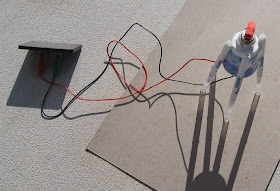With Earth Day coming up this week, we decided it might be fun to give a scribble-bot solar make-over.
We had an old solar cell left over from a Klutz Solar Car book, as well as the alligator clipped wires...
...and all the various hobby motors, that we had picked up for our battle-bots.
The solar cell had screws on the back...
...to clip the wires to, making it very easy to attach to one of the motors, for a test run.
We started out with our smallest offset motor, stuck in a small paper cup. The motor worked with the solar cell. But, we quickly decided it was not strong enough to move the cup as much as we would need for a full out scribble-bot. Instead, we switched over to one of our standard hobby motors (like the one that came originally with the solar cell in the Klutz book), offset with a pencil eraser, before adding the markers, or in this case - the Crayola No-Drip Watercolor Paint Brushes (which happen to be ideal for scribblebots) to the cup.
So far, it was all just standard scribblebot design, like you can find on many different websites. Working with the solar cell however, added some unique challenges.
First off, we couldn't get the larger motor to run, even when it appeared the solar cell was in the sunlight.
We tried kick-starting the motor by spinning the eraser, manually, a few times.
Then, just to be safe, we tested the motor with a AA battery, to make sure it was functioning - which it was.
Finally, we took the whole thing outside, and tried turning the solar cell until it was casting the longest shadow possible. At first, there was nothing, but after one more try at kick-starting the motor with a spin of the eraser...
...we had success. Or, at least something close to success. The motor was moving, but slower than it did when we tested it with a battery, producing a stilted, straight line kind of scribble...
...instead of the exciting curly-ques we could get with battery power.
Returning to the drawing board, we switched back to the smaller motor. Which, while not powerful, did spin quickly when powered by the solar cell. To make up for the loss in power, we lightened our design, using the top of a plastic egg shell (left over from our insect eye glasses), and mini-markers in place of the paper cup, and paint brushes.
Armed with our new knowledge of the importance of careful positioning of the solar cell to catch the optimum amount of sunlight, we were able to move back inside...
...with positive results. We still weren't getting quite the scribble power we wanted, but we were getting closer...
...and the girls were completely fascinated by how instantly the motor stopped and started, as they blocked...
...and unblocked the sun from the solar cell.
The sun was sinking quickly though, so we had to pack it in for the evening, leaving us with another problem to address. Namely, how do we store solar power to use once the sun goes down?
We hope to find out, tomorrow.
















What a fantastic hands-on demonstration of the sun's energy! I'm always filled with admiration for your tenacity with those little robots. They are so fiddly!
ReplyDeleteWhat AWESOME learning! I love all that you all do.
ReplyDeleteBlessings, Dawn
What a cool and fun study!
ReplyDeleteI really need to get some motors like that.
ReplyDeleteHow cool is that! It seems that we won't see any solar plants in Montana though anytime soon ;)
ReplyDeleteMy son was standing behind me whilst I was reading this and every so often I'd hear him going, 'Cool', 'So cool', then it was followed by....'Mummy, why don't we school like this....'
ReplyDeleteHe's right, this is very cool. I particularly appreciated how you tried lots of different ways to improve on the design. This is truly science/engineering at its very best! Well done Leah's children!!